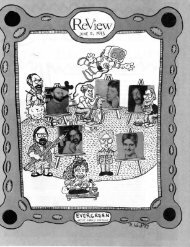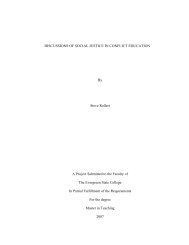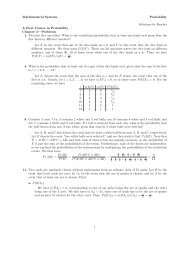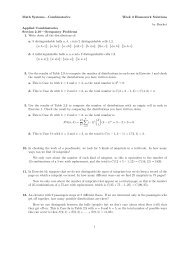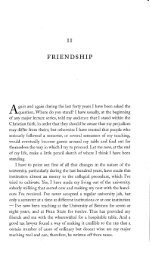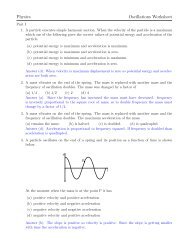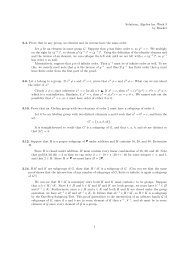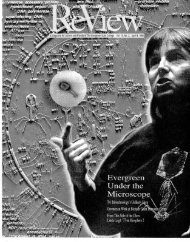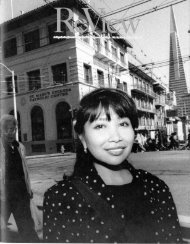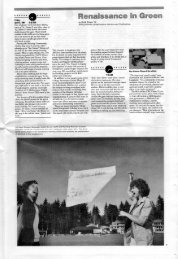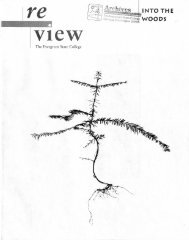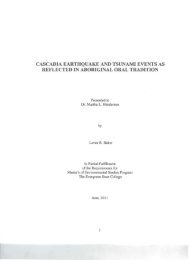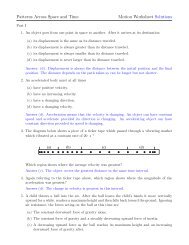V13 #1 December 1991 - Archives - The Evergreen State College
V13 #1 December 1991 - Archives - The Evergreen State College
V13 #1 December 1991 - Archives - The Evergreen State College
You also want an ePaper? Increase the reach of your titles
YUMPU automatically turns print PDFs into web optimized ePapers that Google loves.
What Will Be, Is<br />
by Michael Wark<br />
<strong>Evergreen</strong>'s culture has just completed a<br />
year-long "physical examination" called an<br />
ethnography that revealed some fascinating<br />
patterns and traditions on campus, including<br />
an amazing amount of similarity between<br />
<strong>Evergreen</strong>'s early days and the <strong>Evergreen</strong> of<br />
<strong>1991</strong>.<br />
For instance, Charles McCann, <strong>Evergreen</strong>'s<br />
founding president, described the "right" climate<br />
for learning in a paper called "Vital<br />
Undergraduate Studies" in 1969, before the<br />
first student stepped onto campus.<br />
"You get a real jolt when you're reading<br />
that paper and realize he's describing what's<br />
happening at <strong>Evergreen</strong> today," says Peter<br />
Tommerup, the ethnographer hired by the<br />
college's Assessment Committee to take a<br />
close, anthropological look at <strong>Evergreen</strong>'s<br />
culture.<br />
Tommerup got another jolt reading an<br />
article by founding Dean Charles Teske, who<br />
described the organizational culture at the<br />
end of the first year: "<strong>The</strong>re is little room for<br />
boredom, mediocrity or complacency. People<br />
here are intense and involved." Again, the<br />
similarities to present-day <strong>Evergreen</strong> are amazing,<br />
says Tommerup. "Rather than envisioning<br />
what will be, he is describing what was."<br />
<strong>The</strong>se archival papers are just frosting on<br />
the cake in Tommerup's year of research at<br />
<strong>Evergreen</strong>. He interviewed hundreds of students,<br />
faculty and staff, tape recorded many<br />
of their conversations, and had them transcribed<br />
into 1,000 pages of text. Now he'll<br />
throw in a truckload of personal experience<br />
and blend it all together in a final product: a<br />
book-length report providing fascinating insights<br />
into how the <strong>Evergreen</strong> community<br />
works. Although his focus is on the present,<br />
correlations with the past are important.<br />
"Wild successes happen in academic programs<br />
when people are in a spontaneous,<br />
serendipitous mode of working. <strong>The</strong> really<br />
neat things that happen here happen when<br />
people are in that mode," says Tommerup.<br />
Conclusions like this started to surface<br />
after months of hearing and recording stories.<br />
As Tommerup read through his transcripts,<br />
the stories began to "sort themselves" into a<br />
series of themes that he named Discovery,<br />
Initiation, Participation and Separation (See<br />
<strong>The</strong>mes, page 9).<br />
However, two themes operate throughout<br />
everything that happens at <strong>Evergreen</strong>: flexibility<br />
and transformation.<br />
References to the college's early years were<br />
also common, both from people here 20 years<br />
ago and from people who were repeating the<br />
college's "folklore."<br />
"My sense is that it's amazing how much of<br />
the essential culture is still happening here —<br />
including attitudes of caring and compassion<br />
and a value for spontaneity, informality and<br />
flexibility," says Tommerup. "A lot of the<br />
ethos of the culture from the early days still<br />
exists."<br />
Some things have become routine as successful<br />
strategies are repeated and people are<br />
no longer struggling to build a college from<br />
scratch. As the average age difference between<br />
faculty and students grows, some of the<br />
edge has dulled on stories about field study<br />
and potlucks. And a long-standing tradition<br />
of freedom also has its mellowing effect.<br />
"In the beginning, <strong>Evergreen</strong> was digging<br />
its heels in the ground and saying 'we're<br />
different,'" says Tommerup. "To communicate<br />
they were different, some people ran with<br />
the freedom and went wild. Now freedom is<br />
taken for granted so people aren't out to<br />
prove it exists anymore."<br />
"<strong>The</strong>re is lots of room for people to do<br />
things from the bottom up. <strong>The</strong>re's room for<br />
people to personalize their learning experiences<br />
and I don't think that has ever changed,"<br />
he says.<br />
One very strong perception off campus<br />
and across the country is that you can "do<br />
what you want" at <strong>Evergreen</strong>, meaning you<br />
can latch onto an intellectual passion and<br />
pursue it.<br />
<strong>The</strong> <strong>Evergreen</strong> ReView<br />
"I have stories from last year's freshmen<br />
students who say they came to <strong>Evergreen</strong><br />
because you can do what you want, and<br />
stories from faculty who report the same<br />
reason for coming here back in the beginning,"<br />
says Tommerup. "<strong>The</strong>re are so many<br />
true believers here, and there aren't many<br />
cynics, especially in the student population.<br />
<strong>The</strong>y all came here because they believe <strong>Evergreen</strong><br />
is something special."<br />
Tommerup says <strong>Evergreen</strong> really does offer<br />
the flexibility and freedom to explore. What<br />
people find in their explorations often transforms<br />
them; hence the dual themes, flexibility<br />
and transformation. Another example is the<br />
faculty member who arrived as a political<br />
scientist, became a photographer, then a cognitive<br />
psychologist. It's not uncommon for<br />
faculty to follow an interest and transform<br />
themselves outside of their prior disciplinary<br />
boundaries into new areas of study.<br />
One observation persists that <strong>Evergreen</strong><br />
Ethnographer Peter Tommerup can't verify:<br />
<strong>Evergreen</strong> is getting more conservative.<br />
Tommerup does have evidence that the<br />
complaint has been raised since Fall of 1972,<br />
the second year of classes, and that it most<br />
commonly is raised by students who are new<br />
to campus and are responding to college oral<br />
tradition and folklore.<br />
"It seems to be a persistent myth," says<br />
Tommerup, who's now documenting his<br />
research into a book-length report in<br />
California. "One of the last conversations I<br />
had on campus was with a student I met on<br />
my way to having dinner at "<strong>The</strong> Corner,"<br />
who said, 'you know, this college is getting<br />
more conservative all the time.'"<br />
Faculty are happier here, Tommerup found,<br />
because they can go through transformations<br />
to stay intellectually challenged. And it's possible<br />
for them to gain new academic credentials<br />
relatively quickly because they already<br />
have a framework in place.<br />
One storyteller contrasted the college to<br />
traditional liberal arts colleges by describing<br />
<strong>Evergreen</strong>'s style of flux and transformation<br />
as "the liberating arts," rather than the structured,<br />
traditional format that can make you<br />
"feel like you're in a jail."<br />
For students, transformation leads to an<br />
individual voice — what a founding staffer<br />
said has beenreferred to as "finding one's self."<br />
Tommerup developed a prototype, a sort<br />
of common individual experience for students,<br />
to describe how <strong>Evergreen</strong> fosters a<br />
consistently powerful learning experience:<br />
• Being able to take charge of one's own<br />
learning is a central factor in a student's<br />
decision to attend <strong>Evergreen</strong>.<br />
• <strong>The</strong> experience of ambiguity in the process<br />
of getting an education leads to frustration.<br />
• This frustration leads to some kind of "sorting<br />
out process" that teaches students to find<br />
out what matters to them. <strong>The</strong>n they figure<br />
out how to achieve what matters.<br />
• Through this exploratory process, students<br />
probe their environment and ask lots of questions<br />
while working with faculty toward the<br />
"discovery and construction of a meaningful<br />
personal voice." (Common elements of successful<br />
programs will be documented in<br />
Tommerup's report.)<br />
<strong>The</strong> roots of this prototype lie at the very<br />
heart of the college's history, according to<br />
Tommerup. He sees a definite correlation<br />
between the founding faculty's process to<br />
create the college's curriculum.<br />
Flexibility is valuable to everyone on campus,<br />
but for faculty who love to teach, the<br />
experience is especially strong.<br />
•<br />
Although <strong>Evergreen</strong>'s ethnographer. Peter<br />
Tommerup, continues to evaluate a year's<br />
worth of data collected through hundreds<br />
of interviews, archival documents and personal<br />
experience, he provided Review with<br />
preliminary glimpses of major themes he's<br />
iscovered in the <strong>Evergreen</strong> experience.<br />
I<br />
This theme is fascinating to Tommerup.<br />
"When many Greeners first learn about the<br />
college, suddenly they don't want to hear<br />
about any other," says Tommerup. One student<br />
described <strong>Evergreen</strong> as a mecca. Another<br />
said many students describe this<br />
"weird, mystical reason for being here." For<br />
faculty the experience can be similar. One<br />
storyteller talks of being in a dead-end situation<br />
while teaching in a somewhat interdisciplinary<br />
format at a small private college.<br />
Faculty at that college talked in terms<br />
of punching a time-clock and rarely expressed<br />
excitement over teaching and learning.<br />
When a friend was hired at <strong>Evergreen</strong>,<br />
the storyteller realized the current position<br />
was not right and took a short-order cooking<br />
job in hopes the next job would be at<br />
<strong>Evergreen</strong>.<br />
"<strong>Evergreen</strong> is an important symbol for<br />
people," says Tommerup. "People out there<br />
have mythology about the college—it does<br />
something to them."<br />
Finding out what it's like to be here<br />
means having a lot of bubbles burst," says<br />
Tommerup. Across the spectrum of interviewees,<br />
a definite "<strong>Evergreen</strong>" brand of<br />
adjustment became a common theme.<br />
"Afterthe bubbles burst and they think'this<br />
isn't friendly' or 'this isn't wonderful,' they<br />
start to discover that it can be really friendly<br />
and really wonderful, just in a different<br />
way," says Tommerup.<br />
<strong>The</strong> prime example of separation begins<br />
when a student realizes, "I'll be graduating<br />
soon." Tommerup cited two extremes. One<br />
student worked on a contract to catalog and<br />
analyze all she'd learned because she was<br />
experiencing so much anxiety over what to<br />
do after graduation. She didn't feel ready to<br />
leave "the stimulating, interdisciplinary,<br />
problem-solving environment" she had become<br />
accustomed to. Another student carefully<br />
planned the last two years of her education<br />
and was thrilled to land a job in<br />
exactly the field for which she had<br />
prepared in her internships.<br />
When people prepare to leave the college,<br />
they often undertake a careful inventory<br />
of what they've learned and steel themselves<br />
against what appears to be a very<br />
different outside world.<br />
Many faculty go through a fourth stage<br />
Tommerupcalls "Continuation." "Sometimes<br />
deciding to stay can be as difficult as deciding<br />
to leave," says Tommerup.<br />
"You usually have books on their Library<br />
shelves and faculty in their offices, both fitting<br />
into their slots. But for faculty at <strong>Evergreen</strong>,<br />
there are no rigid slots. <strong>The</strong>y not only avoid<br />
pigeon holes that they're plopped into and<br />
can't get out of, they can even teach outside<br />
their original discipline," says Tommerup.<br />
Whatever form they take, transition and<br />
finding one's voice are enduring <strong>Evergreen</strong><br />
qualities.<br />
Looking to <strong>Evergreen</strong>'s future, Tommerup<br />
sees a continuing debate about how to infuse<br />
multiculturalism and math instruction across<br />
the curriculum.<br />
"Multiculturalism is giving the institution<br />
a chance to look at the fundamentals of the<br />
college to see if, for instance, seminars are<br />
really the crux of an effective education. That's<br />
very healthy for the college. Multiculturalism<br />
has been a topic of discussion since the beginning,<br />
but now it's the dominant vision. In 1971<br />
they were worried about getting the college<br />
going. Now multiculturalism is more timely,"<br />
says Tommerup.<br />
<strong>The</strong> next step for Tommerup, who's now<br />
working at his home in California, is the<br />
process of narrowing down a mountain of<br />
data into a pile of prose that will serve as a<br />
summary for the document describing his research.<br />
His report will include hundreds of<br />
stories to illustrate the themes he discovered<br />
in his work, all cataloged without revealing the<br />
identity of the storytellers. <strong>The</strong> report will be<br />
printed and available on campus by spring.<br />
Tommerup pours a lot of humor and passion<br />
into the work he takes very seriously,<br />
noting that "whether people love or hate the<br />
college, in all those hundreds of interviews<br />
nobody ever said it's a boring place."<br />
<strong>The</strong> fluid nature of <strong>Evergreen</strong>'s structure is<br />
fascinating to him and ties neatly into his<br />
doctoral work at UCLA in organizational culture<br />
and folklore.<br />
"<strong>Evergreen</strong> fits a sort of Shangri-La in<br />
my personal mythology," chuckles the ethnographer.<br />
Ironically, his work to document life at<br />
<strong>Evergreen</strong> guarantees him more than a footnote<br />
in the college's institutional folklore —<br />
he'll have his own book-length chapter.



